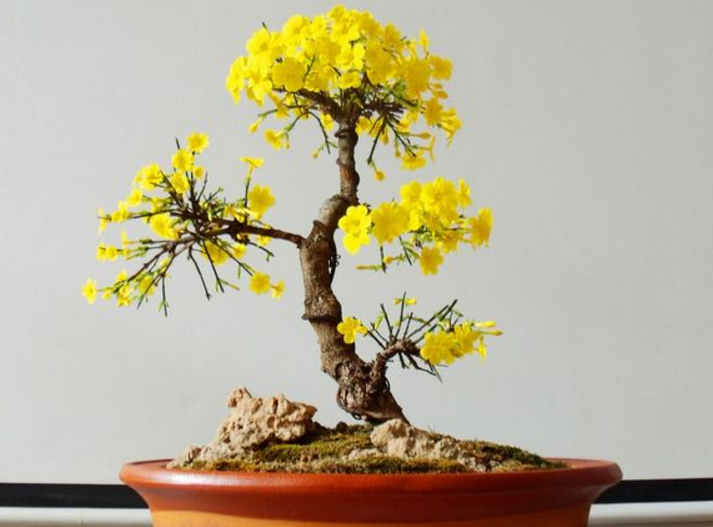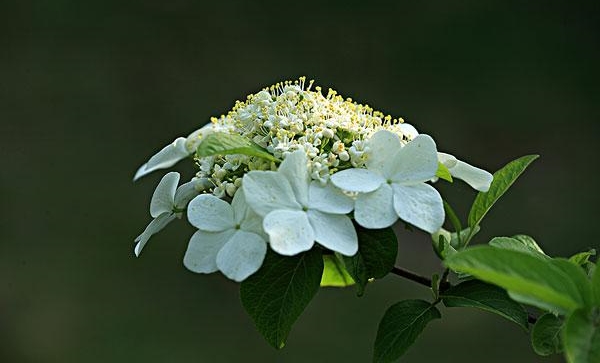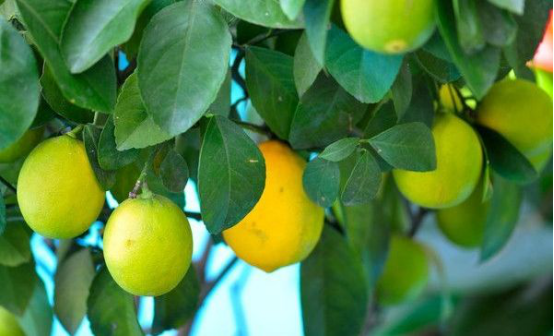The method of making bonsai of primrose
Selection of flowerpots
Material and color:
Primrose bonsai usually choose purple sand pottery basin or glazed pottery basin with medium and deep color. In order to set off the flowers and colors of primrose, darker flowerpots are usually selected, such as dark blue, brown, fuchsia and so on.

Shape:
The shape of the flowerpot is determined by the shape of the primrose, generally choose a round or square, if the cliff type can choose a deep dry tube basin, in order to highlight the beauty of the roots.
Bonsai modeling
The branches of primrose are slender and arched, which are easy to sag, sprout and have well-developed roots, which can be made into root-lifting type, hanging branch type, curved dry type, fan-shaped type, or jungle type bonsai. Due to the strong sprouting ability of primrose, it shoots many times a year, and the branches are soft, and the shape is a combination of flat binding and pruning. The trunk and coarse branches are bent with wire or brown rope, and the lateral branches and twigs are trimmed to control the shape. Pruning is mainly after flowering, cutting off the useless and thin branches, and cutting the retained branches long or short, so as to achieve the effect of "one branch sees twists and turns, two branches are long and short, and three branches will gather and disperse". During the growing period, attention should be paid to coring and short cutting to control the growth and promote branches, focusing on cultivating autumn shoots to blossom and watch.
Turning basin skill
The primrose turns the pot once every two years and is carried out in spring or autumn. When turning the basin, it is combined with root pruning, pruning withered roots or overlong roots to promote the development of fibrous roots. Cake fertilizer can also be placed at the bottom of the basin as base fertilizer when turning the basin.
Some primroses need to lift their roots, lift the plant properly when planting, and obstruct the soil around the roots, gradually watering, the roots will be exposed.
The above is the introduction of the production method of primrose bonsai. Flower friends can try it at home if they like. For more wonderful content, please follow the four Seasons Plant Network!
What is the color of primroses and what are the methods of making bonsai?
Primrose has small slender branches, trifoliolate leaves alternate opposite, its flowers belong to solitary on last year's branches, first the leaves open, with fragrance and golden yellow, dyed red, and its flowering period is in February-April. Because it blossoms earliest among a hundred flowers, and it is after it blossoms that it will usher in a hundred flowers in spring.
[growth habits] Primrose likes the sun, can also be slightly shady, and can survive the winter in the open field in North China for fear of waterlogging, but it requires a warm and humid climate and loose, fertile and well-drained sandy soil as the best choice. It will grow more vigorously in acidic soil, while it will grow poorly in alkaline soil. The germinating power of its root is very strong, and the landing part of the branch is easy to take root.
[color] the same genus of primrose is a lot of red Jasminum: also known as safflower jasmine, is a climbing shrub plant, its Corolla is red or rose red, is with fragrance. Suxin flower: it is a white flower. Primrose: its flowers are yellow and form a terminal multi-flowered Cymes. Jasminum yunnanensis: its flowers are solitary and yellowish with dark spots. Square flowers: Cymes terminal, with several flowers, and are all white, with fragrance.
[potted production] 1. Primroses are generally the most suitable for the use of medium-deep purple sand pottery pots, regardless of shape. Cliff style can use a deep thousand-cylinder basin, and sometimes we can use a shallow basin in order to highlight the beauty of its roots. 2. Primrose likes the sun, is also able to withstand drought and cold, and the requirements for the soil are not strict. Generally, the neutral sandy loam with good drainage is the best. The slightly acidic soil or light saline-alkali soil can also adapt well, it is not resistant to stagnant water, Yingchun potted soil can also be mixed with rotten leaf soil and loam. Of course, we can also use mature vegetable garden soil, nutrient-rich and soft texture are very suitable for the growth and development of primrose.
3. Because the root of primrose is very characteristic, we should first consider how to highlight the posture of its root when pruning it. Of course, it can also remove the soil from its roots during its dormant period, tidy up and climb properly, but it is in a curved shape, just like the ancient roots of pot roots, and then planted in the pot. Its main branches are suitable for bending but not for straightening. Generally speaking, they can be roughed with brown silk. 4. Because the branches of Yingchun are naturally drooping and the roots have characteristics, it is very suitable to be processed into hanging branches and lifting roots, and they are often combined to reveal the roots, while the trunk is made into horizontal or curved dry type, with twigs fluttering and unique charm. Yingchun generally turns the basin every two years, and the time should be after the leaves fall in spring or autumn. When turning the basin, it can be combined with pruning the root system, cutting off the withered root and overlong root, in order to facilitate the development of fibrous root. Bean cake crumbs can also be placed at the bottom of the basin as base fertilizer. If you need to lift the root to welcome the spring, you can lift the root properly when planting, and cover the soil around the root. In the future, with the leaching of watering, the root will be naturally exposed.
Production and price of primrose bonsai culture method of primrose bonsai
Primrose is one of the four Friends in the snow, as famous as plum blossoms, daffodils and camellias. With the change of living environment, more and more people like to cultivate flowers, and bonsai potted plants become the first choice. Next, enjoy the pictures of primrose bonsai and learn the methods of making and breeding primrose bonsai.
First, the method of making bonsai of primrose
1. Flowerpot selection
Primrose bonsai is generally appropriate to use deep color purple sand pottery or glazed pottery, according to the shape of primrose bonsai to determine the shape of the flowerpot. Cliff-style primrose bonsai can be used with a deep thousand-barrel basin, sometimes to highlight the beauty of the roots, but also to use a shallow basin. The color of the flowerpot should be those that set off the beauty of primrose yellow florets, such as dark blue, light blue, dark or purplish red.
2. Bonsai modeling
Yingchun because the branches naturally droop, and the roots have characteristics, so it is very suitable to be processed into the hanging branch type and the root type, and often combine the two, the roots are exposed, while the trunk is made into a horizontal dry type or curved dry type, the twigs are brushed, with unique charm.
3. Pruning method
Cut off the branches after digging up the primroses, because too many branches will die when the roots are damaged, the branches are too short and the buds are not easy to pull out, and 1/3 of the roots are exposed. After planting, do not expose the sun in the shade, be careful not to water too much, wait until after survival to look at the shape of primroses, and trim them properly. To control the growth of primrose branches, too long will affect the overall shape of the treatment.
4. Basin-turning skills
Yingchun generally turns the basin every two years, and the time should be after the leaves fall in spring or autumn. When turning the basin, it can be combined with pruning the root system, cutting off the withered root and overlong root, in order to facilitate the development of fibrous root. Bean cake crumbs can also be placed at the bottom of the basin as base fertilizer. If you need to lift the root to welcome the spring, you can lift the root properly when planting, and cover the soil around the root. In the future, with the leaching of watering, the root will be naturally exposed.
Second, the price of primrose bonsai
The price of primrose is composed of many elements, one is the shape, but depends on the pot age, the important thing is to look at the size! Nowadays, people who raise spring all like to welcome the spring with a single book, and the price of being thick and thin must be very high. Curvature is also important! As the saying goes: there is no right price for flowers! A person with a vision! Now the price of spring has gone up so much that a thousand yuan and a few thousand yuan can no longer buy a good spring! Haochun has been collected by individuals, and the wild ones have been dug very little, and Yingchun has irreplaceable appreciation space and potential!
Third, the method of bonsai culture of primrose
1. Temperature: freshly planted or newly changed jasmine bonsai should be watered thoroughly, placed in a shaded place for about 10 days, and then placed in a semi-overcast and semi-sunny place for a week, and then placed in a sunny, well-ventilated and humid place for maintenance. In winter, the south can safely survive the winter by burying the pot to welcome spring in the leeward and sunny soil, while in the north, it should be moved to a low temperature (about 5 ℃) indoor in the early winter. If you want to make Yingchun blossom ahead of time, you can timely move it into the sunny room at medium temperature or high temperature. If you put it in the sunny part of the room at about 13 ℃, spray clear water to the branches and leaves twice a day and blossom in about 20 days; if placed in the sunny part of the room at about 20 ℃, you can blossom in about lo days. After flowering, keep the room temperature at about 8 ℃, and be careful not to let the wind blow directly to it, which can prolong the flowering period. After blooming, the higher the room temperature, the faster the flowers wither.
2. Watering: welcome the spring to be wet, especially in the hot summer, in addition to watering once every morning, it should also be watered properly in the afternoon. In order to maintain the humidity of the small environment, water should be sprayed to the ground frequently. Yingchun is afraid of stagnant water in the basin. During the rainy season, when it rains continuously, the basin should be put down or moved to a place free from rain. Low temperature in winter, less water evaporation, should be less watering.
3. Fertilization: when planting to welcome the spring, several pieces of animal hooves should be put at the bottom of the bowl as base fertilizer. During the spring growing period, 1 Murray should be applied twice a month to mature and thin liquid fertilizer. The period from July to August is the differentiation period of spring flower buds, and liquid fertilizer with more phosphorus should be applied to facilitate the formation of flower buds. Such as in the early stage of flowering, the application of a rotten thin organic liquid fertilizer can make the flower color bright and prolong the flowering period.
4. Pruning: the primrose has a strong germinating power. During the growth period, it is necessary to often pick the heart, cut off or cut off some branches in order to maintain the tree shape. After the flower withered, the branches should be cut short, generally leaving only 2 Murray 3 buds, the main branch can leave a few more buds, after the emergence of new branches, if properly maintained, buds will grow.
5. prevention of diseases and insect pests: there are very few diseases and insect pests in the spring, and red spiders occur occasionally, which should be eliminated in time.
The above is the introduction of the relevant knowledge of primrose bonsai. Primrose is a good ornamental flower in cold winter and early spring, and bonsai can be trimmed and reshaped at will.
- Prev

The Propagation method of Qionghua
Grafting propagation we generally choose to carry out grafting propagation around March to April every year, because the climate at this time is more suitable and can improve the survival rate of grafting. Then, first select the branches of the mother tree that can blossom, then cut off the 5cm or so as the scion, and propagate with the method of high grafting.
- Next

The reason for the loss of leaves of potted lemon
The reason for the loss of leaves in potted lemons may be due to adaptation period, excessive watering, root rot or red spider damage. When farming, you can reduce watering appropriately, and in the north, you can also pour some acid ferrous acid solution. if the root system is rotten, wipe off the flower buds of lemon, and then cut off the rotten roots.
Related
- Fuxing push coffee new agricultural production and marketing class: lack of small-scale processing plants
- Jujube rice field leisure farm deep ploughing Yilan for five years to create a space for organic food and play
- Nongyu Farm-A trial of organic papaya for brave women with advanced technology
- Four points for attention in the prevention and control of diseases and insect pests of edible fungi
- How to add nutrient solution to Edible Fungi
- Is there any good way to control edible fungus mites?
- Open Inoculation Technology of Edible Fungi
- Is there any clever way to use fertilizer for edible fungus in winter?
- What agents are used to kill the pathogens of edible fungi in the mushroom shed?
- Rapid drying of Edible Fungi

